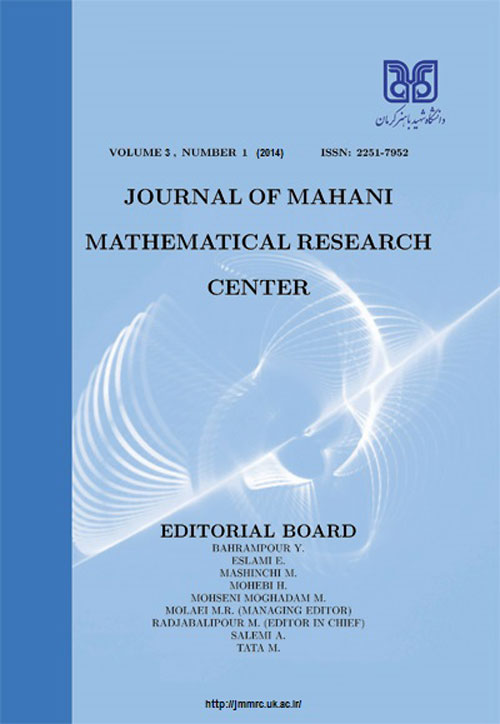فهرست مطالب

Journal of Mahani Mathematical Research
Volume:5 Issue: 1, Winter and Spring 2016
- تاریخ انتشار: 1394/12/20
- تعداد عناوین: 6
-
Pages 1-7There are di erent ways to code the geodesic flows on surfaces with negative curvature. Such code spaces give a useful tool to verify the dynamical properties of geodesic flows. Here we consider special subspaces of geodesic flows on Hecke surface whose arithmetic codings varies on a set with in nite alphabet. Then we will compare the topological complexity of them by computing their topological entropies.Keywords: topological entropy, arithmetic coding, Hecke surface
-
Pages 9-25ýIn this paperý, ýfirst we discuss a local stability analysis of model was introduced by Pý. ýJý. ýMumby etý. ýalý. ý(2007)ý, ýwith $\frac{gM^{2}}{M}$ as the functional response termý. ýWe conclude that the grazing intensity is the important parameter to control the existence or extinction of the coral reefý. ýNextý, ýwe consider this model under the influence of the time delay as the bifurcation parameterý. ýWe show that for small time delayý, ýthe stability type of the equilibria will not changeý, ýhowever for large enough time delayý, ýthe interior equilibrium point become unstable in contrast to the ODE caseý. ýAlso for some critical grazing intensity and the time delayý, ýa Hopf bifurcation occur and a nontrivial periodic orbit will appearý. ýFurther we discuss its corresponding stability switching directionsý.Keywords: Ordinary differential equation, Delay differential equation, Stability, Hopf bifurcation, periodic solution
-
Pages 27-31In this paper, we introduce and study the notion of precompact topological generalized groups and some new results are given.Keywords: Generalized group, precompact topological generalized group, paratopological generalized group
-
Pages 33-50In this paper, a three dimensional mathematical model for HTLV-1infection with intracellular delay and immune activation delay is investigated. By applying the frequency domain approach, we show that time delays can destabilize the HAM/TSP equilibrium, leading to Hopf bifurcations and sta- ble or unstable periodic oscillations. At the end, numerical simulations are illustrated.Keywords: CTL response, Graphical Hopf bifurcation theorem, Fre- quency domain, Delay di erential equation, HTLV-1 infection
-
Pages 51-57In this article, a mathematical model describing the growth or terminating myelogenous leukemia blood cancer's cells against naive T-cell and e ective T-cell population of body, presented by fractional di erential equations. We use this model to analyze the stability of the dynamics, which occur in the local interaction of e ector-immune cell and tumor cells. We will also investigate the optimal control of combined chemo-immunotherapy. We claim that our fractional di erential equations model is superior to its ordinary di erential equations counterpart in facilitating understanding of the natural immune interactions to tumor and of the detrimental side e ects which chemotherapy may have on a patient's immune system.Keywords: Fractional di erential equations, Stability, Myelogenous leukemia blood cancer
-
Pages 59-67In this paper at rst, a history of mathematical models is given. Next, some basic information about random variables, stochastic processes and Markov chains is introduced. As follows, the entropy for a discrete time Markov process is mentioned. After that, the entropy for SIS stochastic models is computed, and it is proved that an epidemic will be disappeared after a long time.Keywords: Epidemic Model, Entropy, Markov chain, Stochastic process

